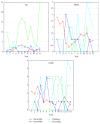Automatic Training of Rat Cyborgs for Navigation
- PMID: 27436999
- PMCID: PMC4942600
- DOI: 10.1155/2016/6459251
Automatic Training of Rat Cyborgs for Navigation
Abstract
A rat cyborg system refers to a biological rat implanted with microelectrodes in its brain, via which the outer electrical stimuli can be delivered into the brain in vivo to control its behaviors. Rat cyborgs have various applications in emergency, such as search and rescue in disasters. Prior to a rat cyborg becoming controllable, a lot of effort is required to train it to adapt to the electrical stimuli. In this paper, we build a vision-based automatic training system for rat cyborgs to replace the time-consuming manual training procedure. A hierarchical framework is proposed to facilitate the colearning between rats and machines. In the framework, the behavioral states of a rat cyborg are visually sensed by a camera, a parameterized state machine is employed to model the training action transitions triggered by rat's behavioral states, and an adaptive adjustment policy is developed to adaptively adjust the stimulation intensity. The experimental results of three rat cyborgs prove the effectiveness of our system. To the best of our knowledge, this study is the first to tackle automatic training of animal cyborgs.
Figures











References
-
- Holzer R., Shimoyama I. Locomotion control of a bio-robotic system via electric stimulation. Proceedings of the IEEE/RSJ International Conference on Intelligent Robot and Systems (IROS '97); September 1997; Grenoble, France. pp. 1514–1519. - DOI
-
- Kuwana Y., Shimoyama I., Miura H. Steering control of a mobile robot using insect antennae. Proceedings of the IEEE/RSJ International Conference on Intelligent Robots and Systems; August 1995; pp. 530–535.
-
- Brown S. Stealth sharks to patrol the high seas. New Scientist. 2006;189(2541):30–321. doi: 10.1152/japplphysiol.01190.2005. - DOI
MeSH terms
LinkOut - more resources
Full Text Sources
Other Literature Sources

